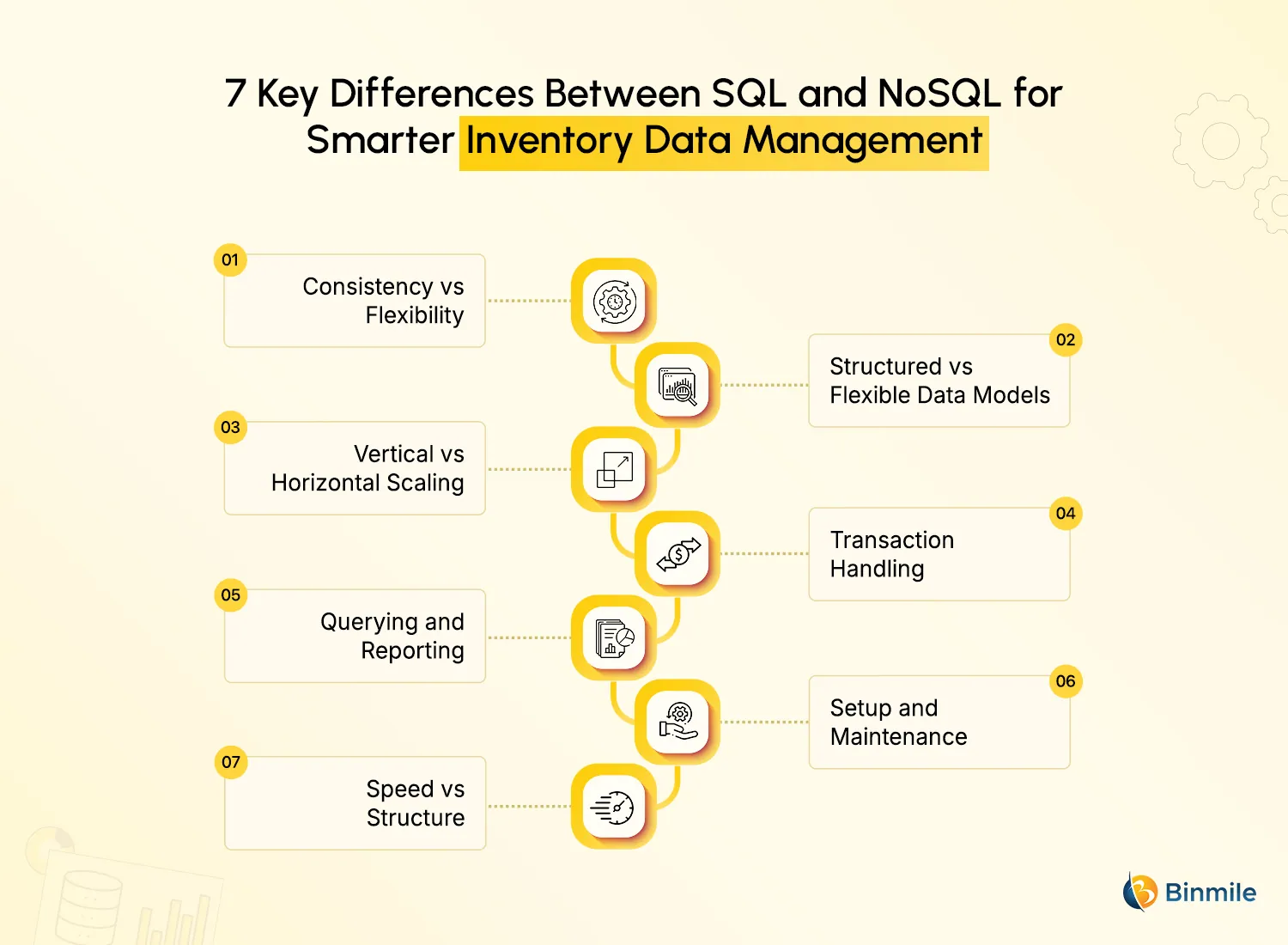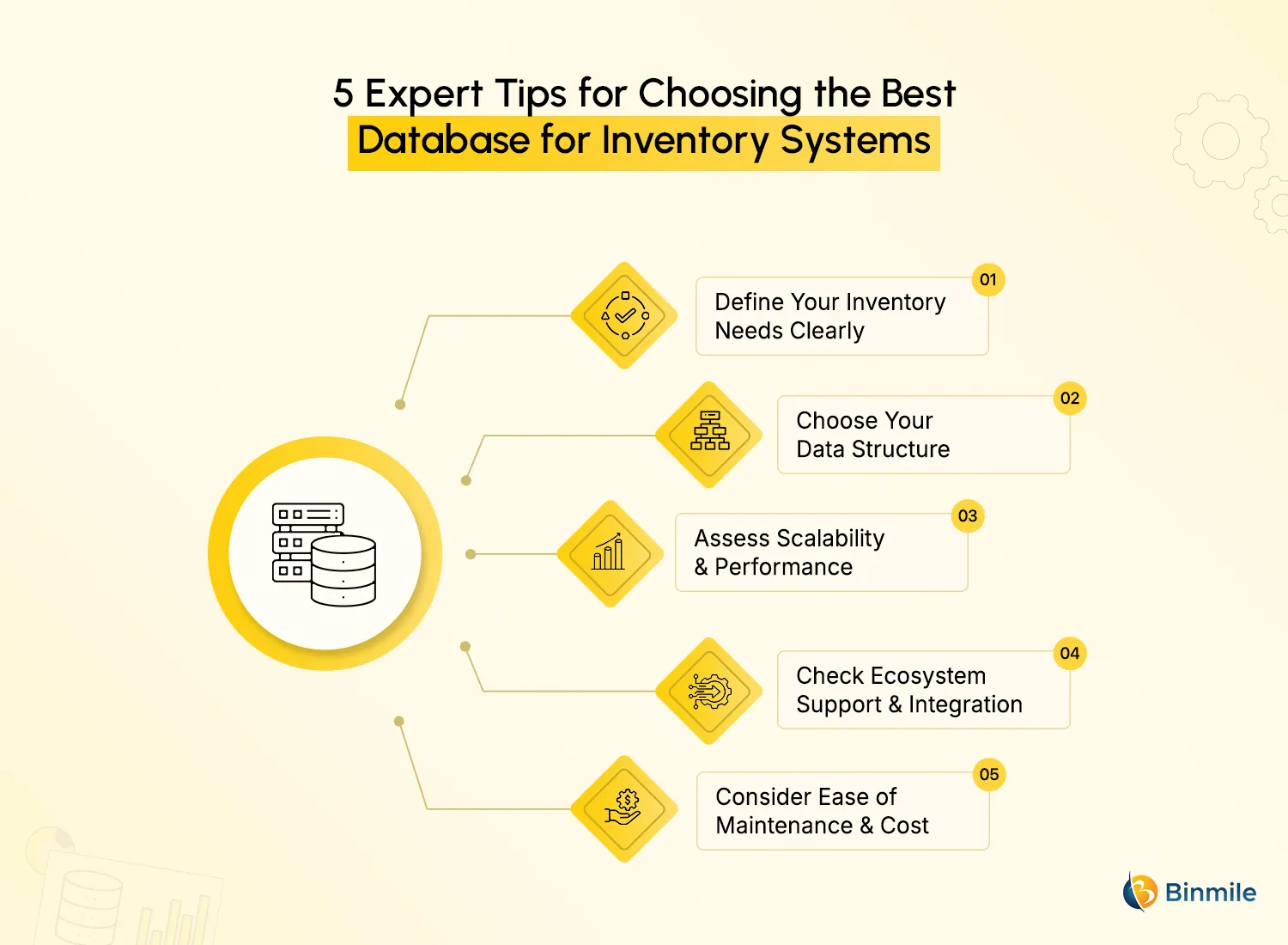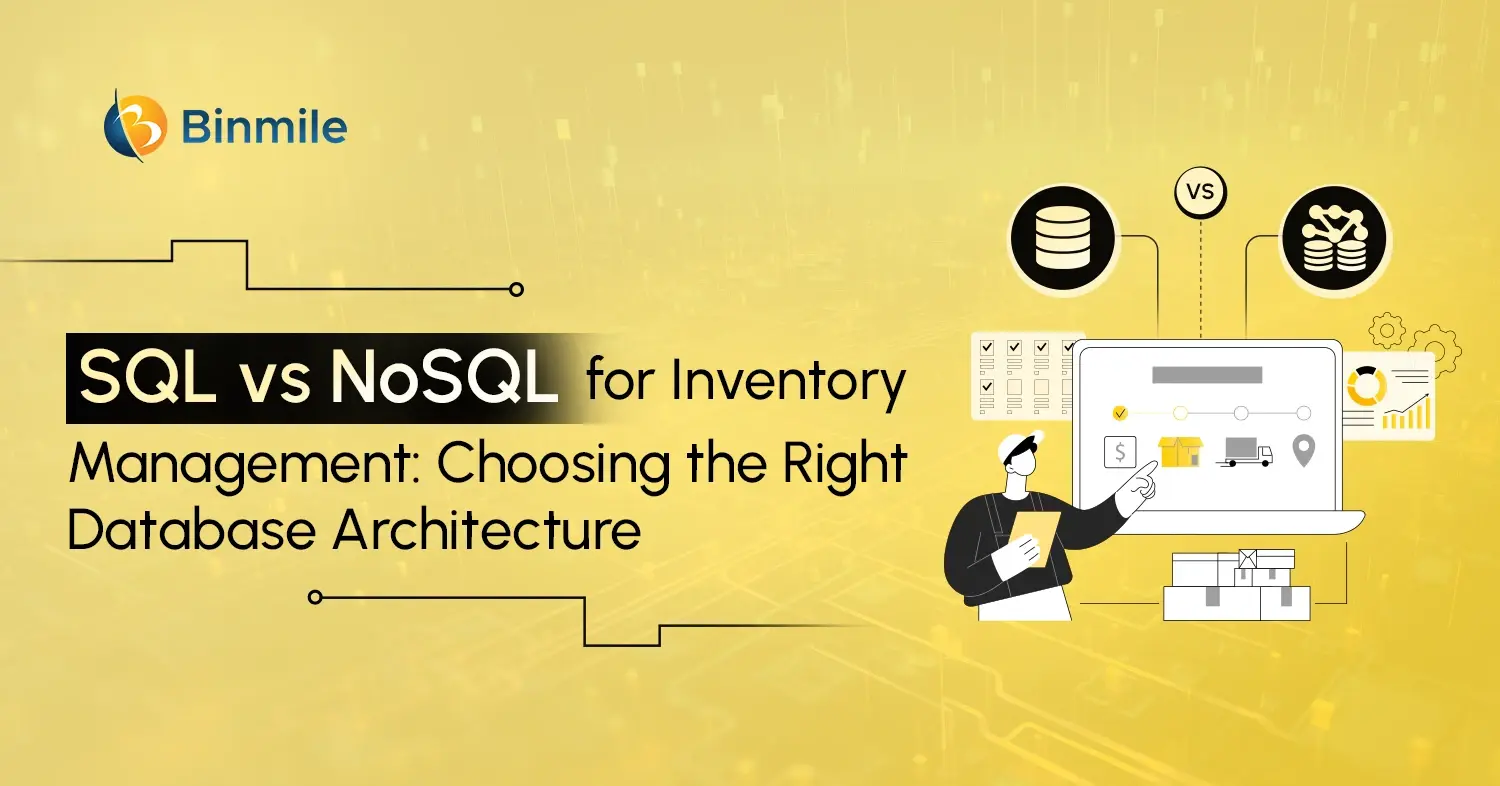- database for inventory management system
- disadvantage of SQL DB
- drawbacks of NoSQL
- features of NoSQL
- features of SQL
- perks of NoSQL
- perks of SQL DB
- SQL and NoSQL database comparison
- SQL vs NoSQL
- SQL vs NoSQL Database
- SQL vs NoSQL for inventory management
- when to choose NoSQL database
- when to choose SQL database
From small online retailers to enterprise supply chains, inventory systems are what drive operations. They track what’s in stock, what’s selling, and what needs restocking, sometimes across hundreds of locations and thousands of SKUs. To make this work, businesses rely heavily on the database that powers their inventory system. The thing is, not all databases are built the same. Choosing the right type directly impacts the system’s performance, its ability to scale with growing inventory, and how efficiently it can be maintained over time. A mismatch here can lead to bottlenecks, operational strain, or even missed sales. Two primary options in databases for inventory management dominate the conversation: SQL vs NoSQL DB.
However, each handles structure, scalability, performance, and complexity in very different ways. That’s where data analytics service teams start asking the real questions. What’s the difference? Does one perform better for real-time stock tracking? And most importantly, which one is the right fit for your inventory management system? If you’re also wondering about these questions, then this blog is for you. In this blog, we’ll explore SQL and NoSQL database comparison, discuss how they manage data behind the scenes, and help you understand where each shines (and where it doesn’t) when it comes to more intelligent inventory control.
What is SQL?
SQL, or Structured Query Language (SQL), is a programming language that enables users to store and process data in a relational database. Businesses can utilize SQL statements to store, update, delete, search, and retrieve information from the database, as well as maintain and optimize database performance.
Key Features of SQL
- SQL enables robust data retrieval using flexible SELECT statements.
- It allows seamless insert, update, and delete operations for managing databases.
- SQL supports defining and altering structured schemas through DDL commands.
- With GRANT and REVOKE, SQL ensures robust security and user permissions.
- It excels at summarizing data using functions like COUNT, AVG, and GROUP BY.
Examples of SQL: MySQL, PostgreSQL, Microsoft SQL Server
Pros of SQL Database for Inventory Management
- It excels at organizing inventory data in relational tables for easy tracking and management.
- It enables quick retrieval of stock levels, reorder points, and vendor details.
- SQL scripts can automate recurring inventory checks and updates.
- It supports advanced reporting for forecasting and demand analysis.
- SQL provides role-based permissions to safeguard inventory data.
Cons of SQL Database for Inventory Management
- Handling massive, complex datasets can require optimization beyond basic SQL.
- Schema changes for dynamic inventory structures can be cumbersome.
- Mastering efficient queries demands strong technical understanding.
- Native SQL lacks built-in support for real-time inventory tracking without add-ons.
What is NoSQL?
NoSQL, or “Not only SQL,” refers to non-relational databases that store data in a non-tabular format, rather than in rule-based, relational tables like those found in traditional relational databases. This database for an inventory management system includes graphs, documents, and key-value pairs. It utilizes a flexible schema model that supports a wide variety of unstructured data, including documents, key-value pairs, wide columns, and graphs.
NoSQL is one of the top databases for web applications or modern applications because they are horizontally scalable, which means developers can add more nodes to enhance processing capacity without modifying the existing infrastructure.
Key Features of NoSQL
- NoSQL databases handle large volumes of data across multiple nodes to improve speed and reliability.
- They support horizontal scaling effortlessly, adding more servers without disrupting operations.
- Flexible schemas and rich query language, e.g., MongoDB’s expressive queries.
- Ease of use for developers.
- NoSQL databases maintain data accessibility even when some nodes fail or become unreachable.
Types of NoSQL: Document-based, Key-value, Wide-column, Graph
Examples of NoSQL: MongoDB, Cassandra, Redis
Advantages of NoSQL Database for Inventory Management
- NoSQL supports flexible, schema-less data models ideal for fluctuating inventory formats and product structures.
- It scales horizontally, enabling seamless performance across expanding inventory databases and global locations.
- Built-in replication and sharding boost fault tolerance and ensure data is consistently available.
- It handles unstructured inputs, such as IoT sensor data, supplier feeds, and SKU metadata, with ease.
- Rapid write operations make it ideal for real-time inventory management, such as quick stock updates and high-frequency transactions.
Disadvantages of NoSQL for Inventory Management
- Many NoSQL systems trade off ACID compliance, risking transactional integrity in multi-step inventory operations.
- Limited support for complex joins can slow down relationship-heavy queries, such as supplier-inventory mappings.
- Maintaining consistency across distributed nodes poses a challenge for synchronized inventory snapshots.
- Developer and ops teams may face a steeper learning curve due to custom configurations and evolving query paradigms.
SQL vs NoSQL DB Comparison: A Quick Overview
| Hourly Average Cost | $15 – $40 | $40 – $200 |
|---|---|---|
| Factors | SQL | NoSQL |
| Data Models | Structured schemas with rows and columns | Flexible, schema-less; varied fields allowed |
| Examples | MySQL, PostgreSQL | MongoDB, Cassandra |
| Consistency vs Flexibility | Strong consistency and data integrity (ACID compliance) | Eventual consistency: faster and more scalable |
| Scalability | Vertical scaling: upgrade server resources | Horizontal scaling: add more machines |
| Querying & Reporting | Powerful, standardized SQL for complex queries | JSON-style or proprietary queries; less intuitive for reporting |
| Transaction Handling | Full ACID transaction support | Limited/default transaction support; may need custom logic |
| Speed vs Structure | More structured, may slow down under heavy relational logic | Optimized for speed; excels in handling massive or unstructured data |
| Setup & Maintenance | Upfront schema design and normalization are required | Quick setup; maintenance complexity grows with scale |
SQL vs NoSQL DB Comparison: What’s the Difference & What to Choose For Inventory Tracking
Managing inventory involves more than just knowing what’s in stock. It’s about tracking product movement in real-time, syncing data across multiple platforms, forecasting demand, and flagging anomalies before they become problems. Your database is what helps you achieve this. So, let’s get into it: SQL vs NoSQL DB, which is better for storing and managing inventory data efficiently?

1. Consistency vs Flexibility
- SQL systems prioritize data integrity and consistency to enhance analytics. That’s particularly important when managing critical data, such as warehouse stock levels, pricing, and order counts, where errors can be costly.
- NoSQL opts for eventual consistency. It’s faster and more scalable, especially when syncing across multiple servers, but there may be a slight delay before all nodes reflect the same data.
2. Structured vs Flexible Data Models
- SQL databases (like MySQL, PostgreSQL) rely on structured schemas. Think rows and columns; every product entry has to follow the same format. It’s predictable, but not always adaptable.
- NoSQL databases (such as MongoDB and Cassandra) are more flexible. You can store inventory records with different fields in the same collection. So if some items have batch numbers and others don’t, you don’t have to redesign the whole structure.
3. Vertical vs Horizontal Scaling
- SQL databases typically scale vertically; you increase server power (CPU, RAM) as the data volume grows, which can become expensive quickly.
- NoSQL databases scale horizontally; you can add more machines instead of upgrading one. This distributed approach handles large data spikes better in your supply chain management.
4. Transaction Handling
- SQL supports ACID-compliant transactions, which helps in effective supply chain operations. For instance, tasks such as “reserve 10 items, update stock, and generate invoice” are completed reliably, either wholly or not at all, thereby maintaining system integrity.
- NoSQL databases support transactions in some cases but may require custom logic for multi-step inventory operations, especially in automated fulfillment systems.
5. Querying and Reporting
- SQL’s query language (SQL) is robust and standardized. You can write complex queries to pull reports on inventory turnover, sales velocity, or re-order thresholds in seconds.
- NoSQL doesn’t have a universal query language. Some use JSON-style queries, others have proprietary syntax. It’s flexible, but not as intuitive for structured reporting.
6. Setup and Maintenance
- SQL databases require upfront planning. You’ll need to define your schema, normalize tables, and set constraints. It’s more work upfront, but it results in a robust system.
- NoSQL enables you to move faster in the early stages of internal software development. However, without a clear data model, maintenance can become messy, especially as your inventory data scales.
7. Speed vs Structure
- NoSQL databases tend to be faster for reads and writes, especially when handling massive data volumes or unstructured data. It’s optimized for real-time performance, product searches, personalization, and real-time recommendations.
- SQL may feel slower under load, but it gives you tighter control, especially for joined tables and relational logic.
Now, let’s understand when SQL is better than NoSQL and when to opt for a NoSQL database to adopt data management trends effectively.
When to Go for NoSQL Database: SQL vs NoSQL DB
- Your inventory includes unstructured or semi-structured data that doesn’t fit well into relational schemas.
- Need to scale horizontally across many servers to accommodate rapidly growing inventories.
- Inventory data frequently changes, requiring flexibility in the schema without requiring migrations.
- Require an inventory system that prioritizes availability and partition tolerance over strict consistency.
- Real-time updates for inventory across distributed locations with low latency are essential.
When is SQL Better than NoSQL: SQL vs NoSQL DB
- Your inventory has a well-defined structure with clear relationships, such as categories and suppliers.
- Strong consistency and transactions (atomicity, consistency, isolation, durability) are crucial in avoiding errors.
- You need to use complex queries with joins and aggregations for reporting and analysis.
- To enforce data integrity vs data quality using foreign keys, constraints, and normalized data.
- The inventory size is manageable and won’t suffer performance hits due to relational overhead.
How to Choose the Right Database System for Modern Inventory Management
Here’s a quick guide for you to understand how to choose SQL vs NoSQL DB that suits your inventory management requirements:

1. Define Your Inventory Needs Clearly
Map out what your systems need to track SKUs, suppliers, batch numbers, stock quantities, and multiple locations. The more specific you are about your needs, the easier it will be to filter out databases that will not support them.
2. Choose Your Data Structure
Choosing the right data structure has a direct impact on performance, scalability, and the database’s ability to support your evolving data lifecycle management needs. So, go for SQL if your inventory is relational, with tables and a fixed schema, it’s the blueprint or structure that defines how data is organized and stored in a database. For dynamic, semi-structured, or document-based data (such as JSON), NoSQL offers greater flexibility and speed necessary to adapt quickly, especially during the early stages of data creation and experimentation, before systems fully mature.
3. Assess Scalability & Performance
Understand how your inventory will grow, as a lightweight local DBMS will be adequate at the moment. Still, when you need high-volume or distributed workloads, you can count on the appropriate PostgreSQL or MongoDB to be very good under peak conditions.
4. Check Ecosystem Support & Integration
Ensure that the DBMS can interact with your cloud-based ERP solutions, POS, or other e-commerce websites or systems. Popular systems like MySQL or Firebase typically provide excellent support for third-party tools, making it more straightforward to build, scale, and troubleshoot.
5. Consider Ease of Maintenance & Cost
Assess continual maintenance, hosting, and licensing, as well as developer familiarization, when making the choice. For instance, open-source DBMS options may save money; however, they will require experts for their implementation. So, it’s worth choosing a solution that is affordable and within your team’s capabilities.
Also Read: MongoDB vs MySQL
Closing Remarks on SQL vs NoSQL: What’s the Difference
To build resilient and efficient inventory systems, both SQL and NoSQL offer valuable capabilities. SQL operates as the dependable foundation, structured, consistent, and built for precision. NoSQL steps in as the flexible, scalable engine, ready to handle evolving data, distributed systems, and speed at scale. However, when it comes to choosing between SQL and NoSQL, there’s no clear winner as these two dynamic database systems address different aspects of the same goal: leveraging data analytics for better data handling, extracting meaningful insights from their data, and driving informed decision-making, whether through structured query logic or scalable real-time intelligence.
So, when you understand and leverage both database types, and which suits your inventory data better, you empower your systems to perform, scale, and adapt with confidence. Not sure which database is best suited for your inventory system? Seeking the consultation of a data engineering services company can be extremely helpful. They’ll assess your technical needs, recommend scalable solutions, and ensure seamless integration to future-proof your system.
Take the guesswork out of your database decision. Let’s talk; our data engineers can help you evaluate your needs and recommend the best-fit solution.









